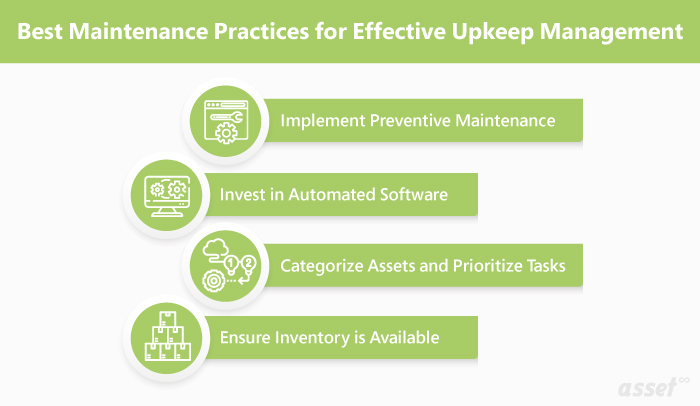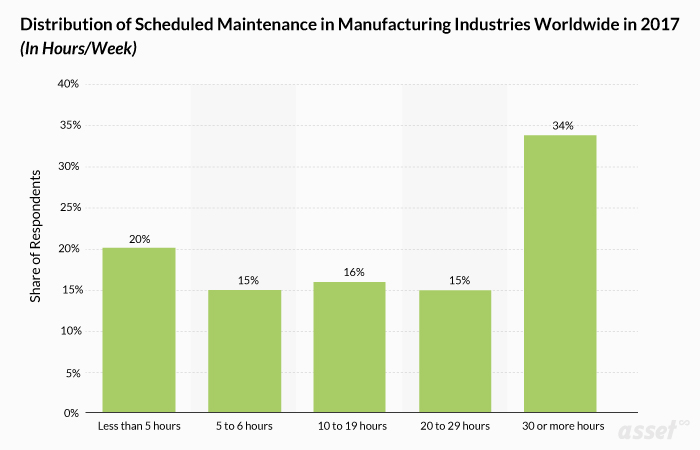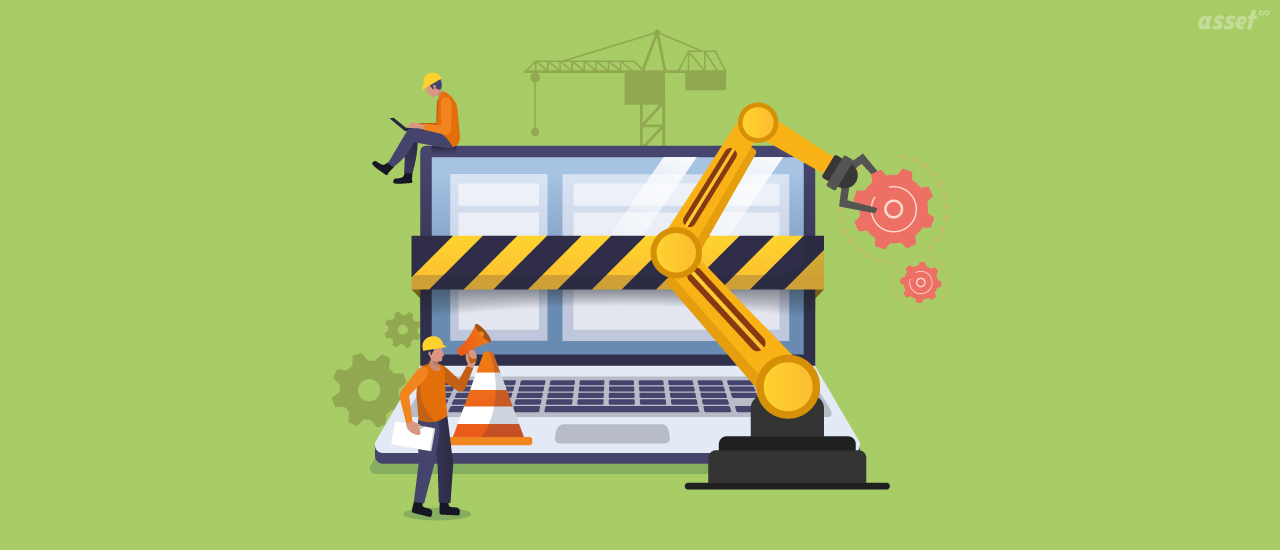Effective maintenance or quality maintenance is very important for assets and equipment. If the maintenance level is not good it will result in quick asset failure, asset performance will decrease before expectations.
Proactive maintenance is the basic need for effective maintenance management and program. There is always room for improving the maintenance program even when you have an organized process.
What Are the Best Maintenance Practices for Upkeep Management?
Best maintenance practices for upkeep management are as follow:

Also Read: What Are the Various Tools Used in Predictive Maintenance?
Implement Preventive Maintenance
Preventive maintenance is a necessity for organizations to improve maintenance. If you have not implemented preventive maintenance then you need to do it the right way.
Why?
This maintenance is a proactive maintenance type. It means that in preventive maintenance actions are taken before there any issue comes, whenever any dangerous sign is noticed such as leakage or sound vibration then the asset is scheduled for maintenance.
Another way of preventive maintenance is scheduling maintenance daily, weekly basis, or monthly basis depending on the usage. In this activity, assets are checked thoroughly and their performance is checked. Engine oil is analyzed to check equipment health. Wear and tear parts are removed and good quality products are used which is important if you want your assets to function properly.
Invest in Automated Software
Software such as CMMS (Computerized maintenance management system) and asset management system are very helpful in improving maintenance programs.
Utilizing the software is one of the most important maintenance management practices as their major functionality revolves around maintenance. it shifts from a manual process to an automated one. Most importantly, it emphasizes preventive maintenance and alerts the team about each particular asset.
It keeps track of asset history and provides crucial data that helps in improving performance to increase asset and equipment efficiency. It also decreases the breakdown failure chances.
Furthermore, they provide reports that have all the data and statistics of assets that help in making crucial decisions related to each asset. These reports are helpful in asset lifecycle management.
According to Statista, “The distribution of scheduled maintenance in the manufacturing industry worldwide in 2017. As of that time, 34 percent of the respondents reported spending 30 hours or more in plant maintenance.”
With the help of software, you can decrease maintenance activity time.

Categorize Assets and Prioritize Tasks
If you want that your business does not get beaten because of assets and equipment then dividing them into a category is significant. When you categorize each asset then it will be easier for your maintenance team to decide and prioritize maintenance tasks.
When a team is not organized, they waste their time doing activities on those assets which are not critical. This scenario is a classic example of unproductive work.
Also Read: Difference Between Availability & Reliability in Terms of Maintenance
For categorization, you can make two lists, critical and non-critical assets list. Critical assets list will have assets which can impact the productivity of business such as conveyor machine, HVAC (Heating ventilation air conditioning), etc. Critical assets have a lot of dependencies. Noncritical assets list can contain which does not have much dependency & work can be done without them.
When you have a list of assets (critical or noncritical) it's become simple for maintenance teams to know on which assets they need to work. It increases overall productivity.
Ensure Inventory Is Available
Sometimes it becomes frustrating when you do not have inventory available in the stock. This scenario occurs when your maintenance team finds that they do not have stock left in the warehouse so you have to wait, postpone the maintenance work.
This is most frustrating when the maintenance team finds it while performing maintenance and they have to do the whole maintenance again and resources wasted.
That is why inventory tracking is necessary for this purpose, asset tracking methods can be used such as Barcode, RFID (Radio-frequency identification), QR Code (quick response code). These technologies provide the location of inventory.
Furthermore, they can be used for tracking the actual number left in the stock with the help of automated software. The software can also help in setting re-order levels for inventory. When staff does inventory count manually it has some margin of human error that can lead to delayed maintenance.
This software avoids this type of problem & converts processes into an automated way. As a result, you can see minimized human error & no delayed response. Furthermore, this function keeps their staff free for other activities.
Conclusion
Maintenance is the backbone of the assets. Asset managers need to keep their asset well maintained so that they don't they give up on you in the hour of need. If that happens then these circumstances are not good for business. In today's world of business one mistake can lead to business and customer loss it means there is no room for error.
That is why the organization must use best maintenance practices in their business. An asset management software is a must when there is so much competition. This software can provide an extra edge to you and your organizations.
This software has the potential to grow your business by saving maintenance expenses and it can assist managers by providing detail of each asset performance. It also plays a crucial role in asset lifecycle management.
Also Read: 7 Reasons to Consider an Asset Management System for Enterprises
Frequently Asked Questions (FAQs)
1. How does reorder feature works in the organization?
With the help of data, assets and equipment history is checked to find average requirement then the re-order point is decided. In software, you set a point whenever the point goes below that level team members will be alerted and the refilling inventory process begins.
2. How does maintenance activity occur?
It works like an alarm; the manager assigns tasks (work order) to the maintenance team. Then it alerts the specific member with asset and date. Furthermore, all the activities that need to be done are mentioned in the checklist. After which technicians perform activities and write their status as well.
3. What is the objective of asset management?
The objective of asset management is to keep the asset in good condition without compromising performance so that return on investment (ROI) increases. It includes activities such as maintenance, calibration, etc.

.webp)
.jpg)
.jpg)


